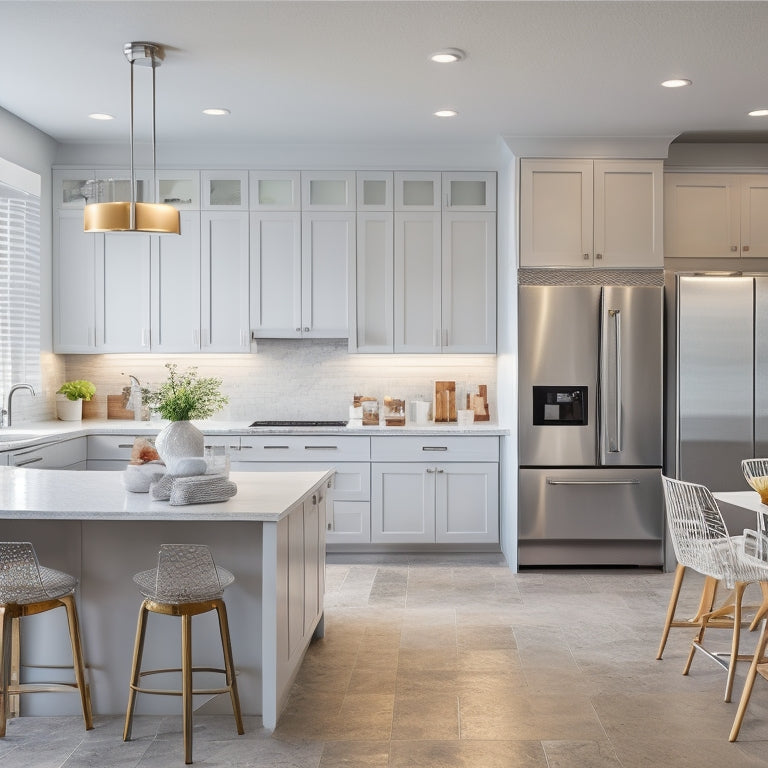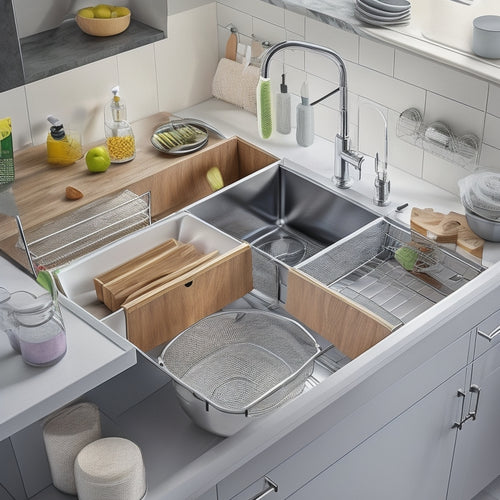
Smarter Kitchen Layouts for Compact Spaces
Share
In a compact kitchen, every inch counts. To create a smarter layout, start by optimizing corner spaces with curved cabinetry and corner carousels. Maximize vertical storage with floor-to-ceiling units and wall-mounted shelves. Then, divide your kitchen into task-specific zones to streamline workflow patterns. Consider a compact island design that incorporates multifunctional features and seating. Don't forget to utilize hidden storage solutions like shelf carousels and pull-out pantries. By strategically placing appliances and prioritizing workflow efficiency, you'll create a kitchen that feels spacious and functional. Now, get ready to discover even more clever design solutions to unleash your kitchen's full potential.
Key Takeaways
• Maximize corner spaces with curved or angled cabinetry, carousels, and shelving to optimize storage and accessibility.
• Utilize floor-to-ceiling storage units, wall-mounted shelves, and pull-down shelves to make the most of vertical space.
• Divide the kitchen into task-specific zones, prioritizing zones for efficient access and allocating prime real estate for frequently used items.
• Incorporate compact island designs with multifunctional features, choosing the right size for efficiency and incorporating seating and lighting.
• Position appliances strategically within the work triangle, prioritizing tasks to minimize walking distances and enhance workflow efficiency.
Optimizing Corner Spaces Effectively
By strategically incorporating curved or angled cabinetry, you can maximize the full potential of your kitchen's corner spaces, often the most underutilized areas in compact kitchens.
Corner carousels are a great solution to this problem, allowing you to easily access items that would otherwise be hidden from view. These clever contraptions rotate with a gentle touch, bringing everything within easy reach.
For a more seamless look, consider curved shelving that hugs the contours of your kitchen's corners. This design element not only creates a sense of flow but also provides ample storage for cookbooks, decorative items, or infrequently used kitchen gadgets.
To make the most of your corner spaces, think about the types of items you need to store and how you can group them logically. For instance, you might dedicate one corner to baking supplies, with a carousel holding mixing bowls and utensils, and another to cooking essentials, with curved shelving displaying your favorite cookbooks.
Maximizing Vertical Storage Capacity
As you've optimized your kitchen's corner spaces, now it's time to look up and tap into the often-wasted vertical real estate above your countertops, where clever storage solutions can make a significant impact on your kitchen's overall functionality.
By installing floor-to-ceiling storage units, you can make the most of your kitchen's vertical space, keeping frequently used items within easy reach while keeping less-used items stored away. Consider wall-mounted shelves, cabinets, or pegboards to maximize storage capacity while maintaining a sense of openness.
These solutions not only provide additional storage but also create a visually appealing, organized look that makes your kitchen feel more spacious. For added convenience, incorporate pull-down shelves or lazy susans to make it easy to access items stored in hard-to-reach areas.
Streamlined Workflow Patterns
You'll be able to move around your kitchen with ease once you've optimized the workflow patterns, creating a seamless shift between tasks by positioning frequently used items and appliances in strategic locations.
This is where Task Segmentation comes in – dividing your kitchen into zones dedicated to specific tasks, such as food prep, cooking, and cleaning. By prioritizing these zones, you'll guarantee that the items you need most are within easy reach, reducing clutter and increasing efficiency.
Zone Prioritization is key to a streamlined workflow. Identify the tasks you perform most frequently and allocate prime real estate accordingly. For instance, if you're an avid baker, consider placing your stand mixer near the center of your kitchen, surrounded by necessary ingredients and utensils. This thoughtful arrangement will save you time and energy, allowing you to focus on the task at hand.
Compact Island Design Solutions
When planning your compact kitchen island, you'll want to explore space-saving shapes, such as a rounded or L-shaped design, that maximize floor space.
Next, contemplate multifunctional features like built-in storage, a sink, or a cooktop to make the most of your island's footprint.
Space-Saving Island Shapes
Two popular space-saving island shapes that can help maximize your compact kitchen's functionality are narrow rectangular islands and circular islands with a diameter no larger than 42 inches. These island shapes can provide additional counter space, storage, and seating without overwhelming the room.
Here's a breakdown of the benefits of each shape:
| Island Shape | Benefits |
|---|---|
| Narrow Rectangular | Ideal for galley kitchens, provides angular silhouettes, and can fit snugly against a wall. |
| Circular (≤ 42 inches) | Offers curved countertops, creates a sense of flow, and can be placed in a corner or as a central hub. |
| Hybrid (Combination) | Combines the benefits of both shapes, offering flexibility in design and functionality. |
| L-Shaped | Provides additional counter space and storage, while also defining different zones within the kitchen. |
| Mobile Cart | Offers flexibility and can be easily moved to different areas of the kitchen, providing extra counter space and storage. |
When choosing an island shape, consider your kitchen's layout, your personal style, and the functionality you need. By selecting the right shape, you can create a more efficient, functional, and aesthetically pleasing kitchen.
Multifunctional Island Features
To optimize your compact kitchen's functionality, incorporate multifunctional island features that combine tasks, such as a built-in cooktop, sink, or storage, to create a highly efficient workspace. By doing so, you'll be able to accomplish more in less space, making your kitchen feel more spacious and organized.
Here are some ideas to get you started:
-
Island Seating:
Add a built-in breakfast bar or a built-in booth to create a cozy dining nook. This won't only provide additional seating but also define the kitchen's social area. -
Island Lighting:
Install pendant lights or under-cabinet lighting to create a warm and inviting ambiance. This will also highlight specific areas of the kitchen, making it easier to navigate. -
Incorporate a built-in wine rack or spice storage to keep your kitchen essentials within easy reach.
- Consider a pull-out trash can or recycling center to keep your kitchen tidy and eco-friendly.
Island Size Optimization
Your compact kitchen island's dimensions are important, and strategically designing its size can greatly impact the overall workflow and functionality of your space. A well-proportioned island can enhance your kitchen's efficiency, while a poorly sized one can create congestion. To optimize your island's size, consider the following guidelines:
| Island Sizing | Counter Proportions |
|---|---|
| Length: 3-4 feet | Counter height: 36 inches |
| Width: 2-3 feet | Counter depth: 24-30 inches |
| ** Clearance**: 42-48 inches | Overhang: 12-18 inches |
When designing your island, remember to balance its size with the available floor space and counter proportions. A general rule of thumb is to maintain a clearance of at least 42 inches around the island to ensure comfortable movement. Additionally, consider the overhang of your countertops to create a functional workspace. By optimizing your island's size, you'll create a more efficient and functional kitchen that meets your needs.
Hidden Storage Opportunities
Corners, often considered dead space, can be transformed into functional storage areas with clever cabinetry and shelving solutions that maximize every inch of your compact kitchen. You can make the most of these hidden spaces by incorporating innovative storage solutions that keep your kitchen organized and clutter-free.
Here are some ideas to get you started:
-
Install shelf carousels to access items in hard-to-reach corners, making the most of vertical space.
-
Use drawer dividers to categorize and store utensils, cookware, and dinnerware, keeping them within easy reach.
-
Opt for pull-out pantries that bring items to you, eliminating the need to dig through crowded shelves.
- Incorporate a lazy Susan in your corner cabinets to effortlessly access items that would otherwise be difficult to retrieve.
Efficient Appliance Placement
As you plan your compact kitchen layout, you'll want to strategically place your appliances to maximize functionality and flow.
By considering the often-wasted space in corners and optimizing the 'work triangle' between your sink, stove, and fridge, you'll create a more efficient kitchen that makes the most of every inch.
Corner Appliance Considerations
By strategically placing appliances in corners, you can reclaim valuable floor space and create a more fluid workflow in your compact kitchen. This thoughtful approach allows you to make the most of your kitchen's unique dimensions.
When considering corner appliances, keep the following key factors in mind:
-
Appliance angles: Choose appliances with adjustable or rotating doors to guarantee easy access from any angle.
-
Corner clearance: Make sure there's enough clearance between the appliance and adjacent walls or cabinets to prevent obstacles and promote smooth traffic flow.
-
Consider the height and depth of your corner appliances to maximize storage potential without obstructing walkways.
- Visual balance: Balance the visual weight of your corner appliances by pairing them with complementary design elements, such as a decorative backsplash or sleek cabinetry.
Work Triangle Optimization
You'll further optimize your compact kitchen's layout by strategically placing appliances within the work triangle, the imaginary lines that connect your sink, stove, and refrigerator, to reduce walking distances and improve overall workflow efficiency. This triangle geometry is essential, as it affects how you move around your kitchen.
By prioritizing tasks, you can determine which appliances you use most frequently and place them accordingly. For instance, if you're a coffee lover, consider placing your coffee maker near the sink, where you'll be washing cups and filling the water reservoir.
To maximize efficiency, position your stove, sink, and refrigerator in a way that minimizes walking distances between each point of the triangle. Aim for a total distance of 10-25 feet between the three points. This will create a smooth workflow, allowing you to move easily between tasks.
Narrow Walkway Navigation
Careful planning is essential to navigate narrow walkways in compact kitchens, where every inch counts and a well-designed layout can make all the difference. You want to feel comfortable moving around your kitchen, not claustrophobic or anxious about bumping into things.
To achieve this, consider the following strategies to optimize your narrow walkways:
-
Walkway Widening: Look for opportunities to widen your walkways by even a few inches. This can be achieved by repositioning appliances, using wall-mounted fixtures, or selecting slim-profile cabinets.
-
Pathway Lighting: Proper lighting can make narrow walkways feel more spacious. Install LED strips, under-cabinet lighting, or pendant lights to create a sense of openness and guide you through the space.
-
Rethink your kitchen's 'dead zones' – areas that are difficult to access or unusable. Consider installing a pull-out pantry or a carousel storage unit to maximize storage and reduce clutter.
- Visual Flow: Create a sense of visual flow by using similar materials, colors, and textures throughout your kitchen. This will help distract from the narrow walkways and create a sense of continuity.
Creative Countertop Utilization
As you reimagine your compact kitchen, you'll want to make the most of every inch - including your countertops. By creatively utilizing this valuable real estate, you'll free up space and improve workflow.
Now, let's explore two essential strategies for maximizing countertop functionality: optimizing corner spaces and maximizing vertical surfaces.
Corner Space Optimization
By cleverly incorporating curved or angled countertops, homeowners can tap into the hidden potential of corner spaces, creating a seamless workflow and maximizing every inch of available real estate. This thoughtful design approach allows you to make the most of your compact kitchen, creating a sense of flow and functionality that makes cooking and entertaining a breeze.
Here are some ways to optimize your corner space:
-
Corner Lighting: Install under-cabinet lighting or pendant lights to illuminate the area, making it easier to access and utilize.
-
Corner Decor: Add a decorative trim or tile to create visual interest and define the space.
-
Use a curved countertop to create a smooth, flowing surface that guides you around the corner.
- Incorporate a pull-out corner drawer or carousel to provide easy access to storage and keep clutter at bay.
Vertical Surface Maximization
Maximizing your kitchen's vertical surfaces means reclaiming often-wasted space above countertops, where cleverly designed shelves, racks, or cabinets can hold everything from cookbooks to kitchen gadgets, keeping them within easy reach while maintaining a clutter-free environment. By doing so, you'll create a sense of airiness and visual flow, making your compact kitchen feel more spacious.
Consider installing wall shelves or ceiling racks to store infrequently used items, such as special occasion dishes, cookware, or baking sheets. This will free up valuable counter and cabinet space for daily essentials. When selecting shelves or racks, look for designs that are adjustable, allowing you to customize the layout to fit your specific needs.
To make the most of your vertical surfaces, think vertically. Stackable containers, baskets, or bins can be used to store dry goods, spices, or oils, keeping them organized and out of the way.
Space-Saving Sink Station
Position your sink in a corner, freeing up floor space and creating a more open feel in your compact kitchen. This clever sink placement allows for a more efficient use of space, making your kitchen feel more spacious. When it comes to faucet integration, consider a wall-mounted faucet to save even more space.
Here are some additional tips to create a space-saving sink station:
-
Opt for a compact sink: Choose a sink that's specifically designed for small spaces, such as a pedestal sink or a sink with a smaller footprint.
-
Install a slide-out trash can: Keep your trash can hidden from view and free up floor space with a slide-out trash can.
-
Use a fold-down dish rack: A fold-down dish rack is a great space-saving solution for drying dishes, and can be easily stowed away when not in use.
- Incorporate a built-in soap dispenser: A built-in soap dispenser can help keep your countertops clear of clutter and add a touch of sleek modernity to your sink station.
Smart Cabinet Organization Systems
As you optimize your sink station, turn your attention to the heart of your kitchen's storage: the cabinets, where a smart organization system can unlock hidden space and streamline your workflow.
A well-designed cabinet system can make a significant difference in your kitchen's functionality and aesthetic appeal. Consider installing Soft Close cabinet doors and drawers, which will guarantee smooth, quiet operation and prevent slamming. This feature is especially important in compact spaces where noise can be amplified.
To maximize storage capacity, incorporate Custom Inserts that cater to your specific needs. For instance, you can design inserts for utensil storage, spice racks, or wine glass holders. These tailored solutions will keep your cabinets clutter-free and make the most of the available space.
Frequently Asked Questions
Can I Use a Kitchen Cart to Increase Counter and Storage Space?
You can totally use a kitchen cart to boost counter and storage space! Opt for one with clever cart organization features, like drawers, shelves, and hooks, to maximize space and create a seamless workflow that makes you feel like a pro.
How Do I Choose the Right Lighting for a Compact Kitchen?
When selecting lighting for your compact kitchen, you'll want to balance task lighting, which illuminates specific areas like cooking zones, with ambient illumination, which sets the overall mood, to create a warm and inviting space that feels like home.
Are There Any Specific Design Considerations for a Galley Kitchen?
"You're likely familiar with the feeling of being stuck in a crowded kitchen; did you know that 70% of homeowners consider kitchen layout a top priority? In a galley kitchen, you'll want to create workstation zones and optimize corners with clever storage solutions to maximize efficiency and flow."
Can I Fit a Kitchen Table in a Compact Space, and if So, How?
You can squeeze a kitchen table into a compact space by opting for space savers like wall-mounted or foldable tables, or choosing unique table shapes like circular or hexagonal ones that fit snugly in corners.
What Are Some Affordable Options for a Compact Kitchen Renovation?
You'll find budget-friendly solutions by embracing a budget remodel, tackling DIY updates, and repurposing existing elements. Update cabinetry with fresh hardware, refresh walls with a new coat of paint, and swap out lighting fixtures to give your kitchen a fresh, revamped look.
Related Posts
-

Boost Productivity With Free Google Sheets Templates
You can enhance your productivity exponentially by utilizing free Google Sheets templates, which offer a proven way t...
-

LYNK PROFESSIONAL: Transform Your Under-Sink Storage
Transform your under-sink storage with LYNK PROFESSIONAL, a cleverly designed system that tackles common challenges. ...

